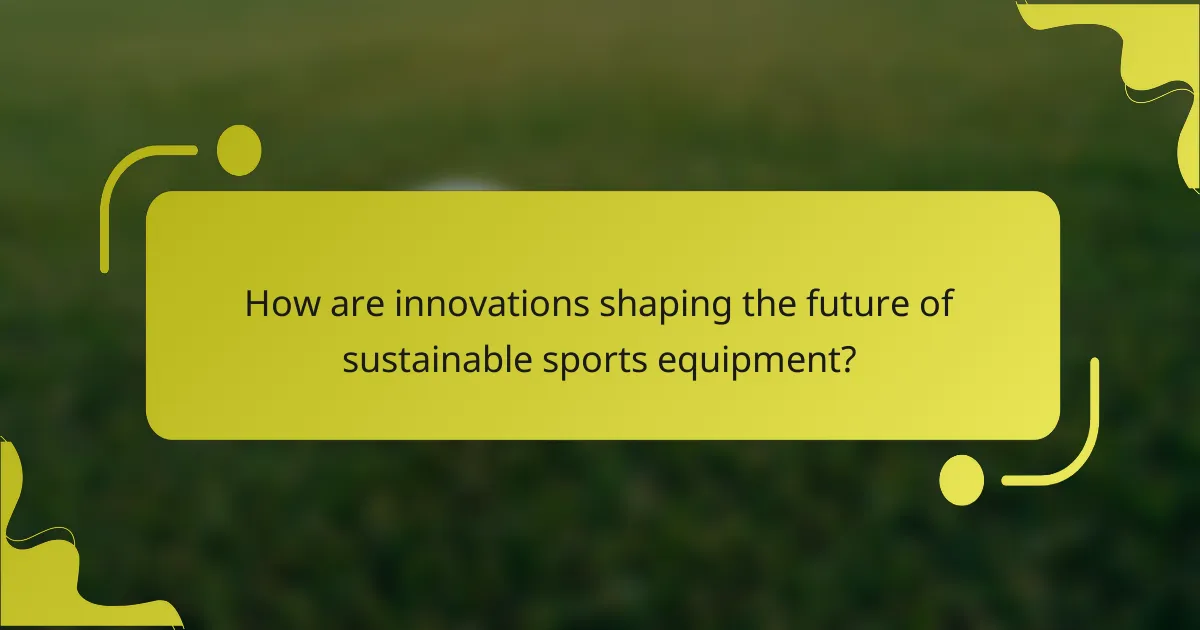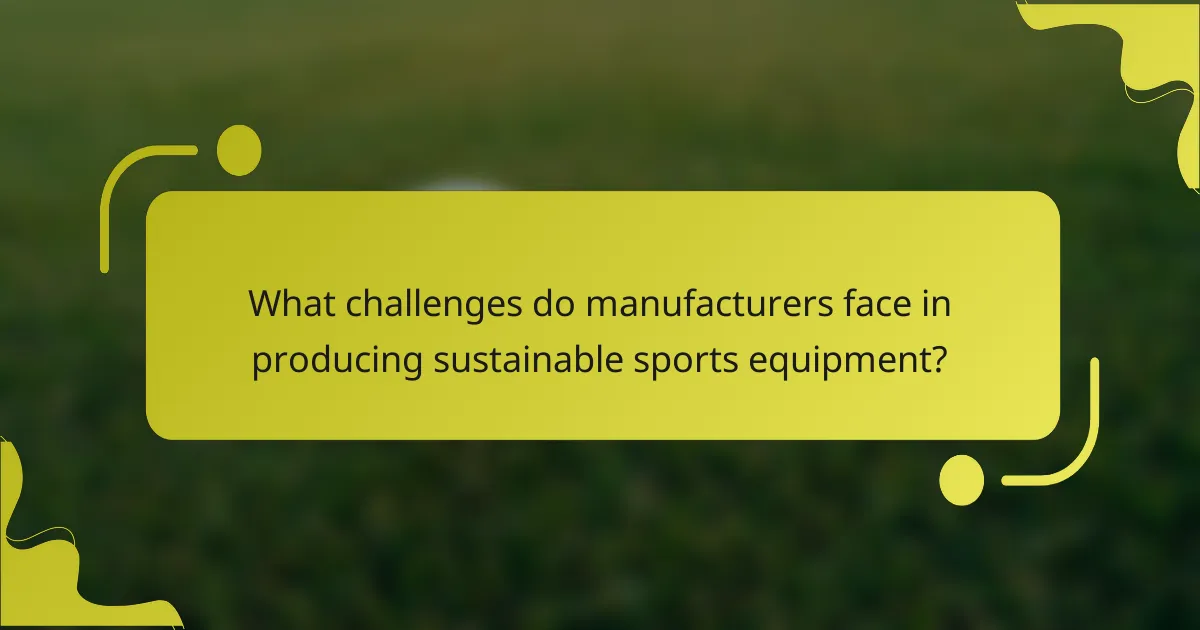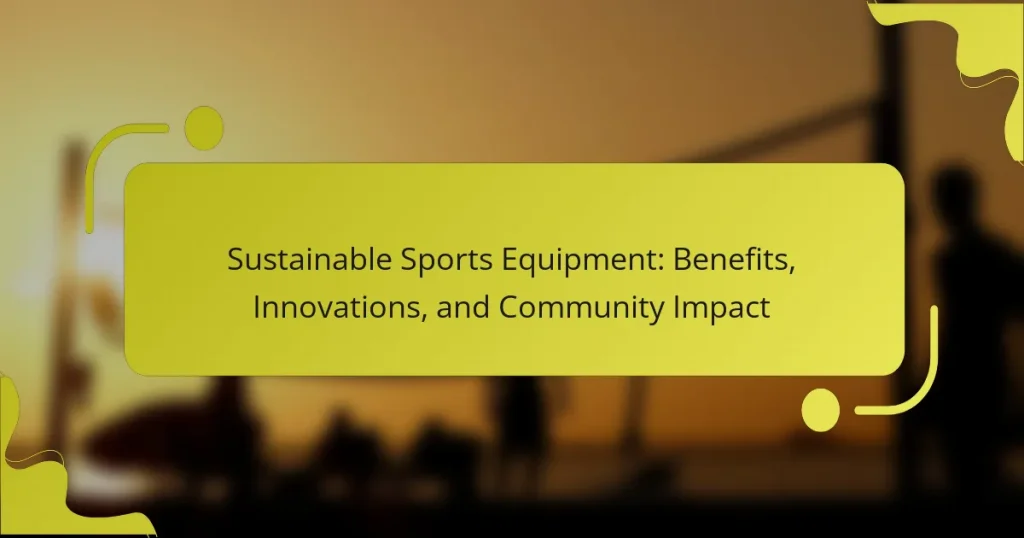Sustainable sports equipment significantly reduces waste and carbon emissions while promoting resource conservation. Innovations in eco-friendly materials and manufacturing enhance performance and durability. This shift fosters community awareness and engagement in environmental responsibility, leading to improved public health and well-being. However, manufacturers face challenges in sourcing sustainable materials and meeting consumer expectations.

What are the environmental benefits of sustainable sports equipment?
Sustainable sports equipment offers significant environmental benefits, including reduced waste, lower carbon emissions, and conservation of resources. These products often utilize eco-friendly materials and manufacturing processes, leading to a smaller ecological footprint. For example, using recycled plastics in sports gear can minimize landfill contributions and decrease the demand for virgin materials. Additionally, sustainable equipment promotes a circular economy by encouraging repair and recycling, further enhancing its positive impact on the environment.
How does sustainable sports equipment reduce carbon footprint?
Sustainable sports equipment significantly reduces carbon footprint by utilizing eco-friendly materials and production methods. These innovations often include recycled or biodegradable components, which minimize waste and emissions during manufacturing. For example, equipment made from recycled plastics can reduce energy consumption by up to 80% compared to traditional materials. Additionally, sustainable practices in logistics and distribution further lower greenhouse gas emissions. By promoting a circular economy, sustainable sports equipment fosters community engagement and awareness about environmental responsibility.
Which materials are most eco-friendly for sports equipment?
Eco-friendly materials for sports equipment include recycled plastics, organic cotton, bamboo, and natural rubber. These materials reduce environmental impact while maintaining performance.
Recycled plastics are durable and help minimize waste. Organic cotton offers a sustainable alternative to conventional cotton, using fewer chemicals. Bamboo grows rapidly and absorbs carbon, making it an eco-friendly choice. Natural rubber is biodegradable and provides excellent grip and cushioning.
Incorporating these materials supports sustainability in sports and encourages a positive community impact.
What role do certifications play in sustainability?
Certifications enhance sustainability in sports equipment by ensuring products meet environmental and ethical standards. They promote transparency and accountability, fostering consumer trust. For example, eco-labels indicate sustainable materials and manufacturing processes, which can reduce environmental impact. Additionally, certifications often drive innovation, encouraging companies to adopt greener technologies. This collective effort supports community well-being by promoting healthier lifestyles and reducing waste.

How are innovations shaping the future of sustainable sports equipment?
Innovations are significantly enhancing sustainable sports equipment by integrating eco-friendly materials and advanced technologies. These advancements reduce environmental impact while improving performance and durability. For instance, brands increasingly use recycled plastics and organic fibers, which lower carbon footprints. Additionally, innovations in manufacturing processes, such as 3D printing, minimize waste and resource consumption.
The community impact of these innovations is profound. Sustainable sports equipment fosters awareness about environmental responsibility among athletes and consumers. As a result, participation in sustainable practices grows, promoting a healthier planet. Furthermore, collaborations between brands and environmental organizations amplify these efforts, creating a collective movement towards sustainability in sports.
What are the latest technologies in sustainable sports gear?
Sustainable sports gear incorporates advanced technologies that minimize environmental impact. Key innovations include biodegradable materials, recycled plastics, and energy-efficient manufacturing processes.
Biodegradable materials, such as mycelium and organic cotton, break down naturally, reducing waste. Recycled plastics are repurposed into durable fabrics, decreasing reliance on virgin resources. Energy-efficient manufacturing employs renewable energy sources, lowering carbon footprints.
Additionally, brands are focusing on circular economy practices, promoting gear recycling and take-back programs. These technologies not only benefit the environment but also enhance performance and durability, fostering a more sustainable sports community.
How do design practices influence sustainability in sports equipment?
Design practices significantly enhance sustainability in sports equipment by prioritizing eco-friendly materials and efficient manufacturing processes. Sustainable design reduces waste and energy consumption, leading to lower carbon footprints. Innovations like biodegradable composites and recycled plastics exemplify these practices, promoting environmental responsibility. Additionally, community impact is evident as brands engaging in sustainable design foster awareness and encourage consumers to support eco-conscious choices.
Which brands are leading the way in innovation?
Leading brands in sustainable sports equipment include Patagonia, Adidas, Nike, and The North Face. These companies prioritize eco-friendly materials and innovative designs to reduce environmental impact.
Patagonia focuses on recycled materials and fair labor practices. Adidas has introduced shoes made from ocean plastic, showcasing their commitment to sustainability. Nike’s Move to Zero initiative aims for zero carbon and zero waste through innovative manufacturing processes. The North Face emphasizes circular economy principles, encouraging recycling and repair of their products.
These brands not only enhance performance but also foster a community-conscious approach to sports. Their innovations contribute to a more sustainable future in athletic pursuits.

How does sustainable sports equipment impact community health and well-being?
Sustainable sports equipment positively influences community health and well-being by promoting eco-friendly practices and enhancing physical activity. These products often use recycled materials, reducing waste and environmental impact. As a result, communities can experience improved air quality and reduced pollution, leading to better overall health.
Innovations in sustainable sports equipment, such as biodegradable materials and energy-efficient manufacturing processes, contribute to healthier lifestyles. When communities invest in such equipment, they encourage active participation in sports and outdoor activities, which can lead to increased social interaction and mental well-being.
Furthermore, sustainable sports equipment can foster a sense of community pride and responsibility. Engaging in environmentally conscious practices can motivate individuals to take better care of their surroundings, creating a healthier environment for all. This collective effort enhances community cohesion, ultimately benefiting public health and well-being.
What are the social benefits of using sustainable sports gear?
Using sustainable sports gear provides significant social benefits, including community engagement, environmental awareness, and support for ethical manufacturing. These products often foster a sense of belonging among users who prioritize sustainability. Additionally, they promote healthier lifestyles, encouraging social interactions through shared values. Sustainable gear also often supports local economies by sourcing materials responsibly and creating jobs in green industries. This collective effort enhances community resilience and environmental stewardship.
How can local communities promote sustainable sporting practices?
Local communities can promote sustainable sporting practices by prioritizing eco-friendly sports equipment. This approach reduces environmental impact while enhancing community engagement.
Communities can support local manufacturers of sustainable sports gear, which often utilize recycled or biodegradable materials. For instance, using equipment made from reclaimed plastics minimizes waste.
Innovations in sustainable sports equipment, such as solar-powered lighting for fields, can further reduce carbon footprints. These advancements encourage participation in outdoor sports while promoting environmental awareness.
Community events focused on sustainable sports practices can foster collaboration. Workshops on equipment recycling and upcycling can educate members on the importance of sustainability in sports.
What initiatives support access to sustainable sports equipment?
Several initiatives enhance access to sustainable sports equipment. Programs like recycling campaigns promote the use of repurposed materials. Organizations offer grants to schools for eco-friendly gear. Partnerships with manufacturers support affordable, sustainable options. Community workshops educate on maintenance and repair, extending equipment life.

What challenges do manufacturers face in producing sustainable sports equipment?
Manufacturers face several challenges in producing sustainable sports equipment. These include sourcing eco-friendly materials, ensuring product durability, and managing production costs.
Sourcing sustainable materials can be difficult due to limited availability and higher prices compared to conventional materials. Additionally, manufacturers must balance sustainability with performance, ensuring that the equipment meets the expectations of athletes.
Production processes also pose challenges, as transitioning to greener methods often requires significant investment in new technologies. Furthermore, consumer demand for sustainable products is growing, but education on the benefits of sustainable sports equipment remains necessary to drive wider adoption.
Lastly, navigating regulatory standards related to environmental impact can complicate manufacturing processes, requiring ongoing adaptation and innovation.
How do cost implications affect the adoption of sustainable materials?
Cost implications significantly influence the adoption of sustainable materials in sports equipment. Higher initial costs often deter manufacturers and consumers despite long-term savings and environmental benefits.
Investing in sustainable materials can lead to reduced operational costs over time, such as lower energy consumption and waste management expenses. For example, using recycled materials can decrease production costs and enhance brand reputation.
However, the lack of industry standards and consumer awareness can create uncertainty around the return on investment. As a result, companies may hesitate to shift from traditional materials, prioritizing short-term financial gains over sustainable practices.
In conclusion, addressing cost implications through incentives and education can encourage the adoption of sustainable materials in the sports equipment industry.
Which regulatory hurdles impact sustainable equipment production?
Regulatory hurdles significantly impact sustainable sports equipment production by imposing stringent standards. These regulations often focus on materials, safety, and environmental impact. Compliance can increase production costs and limit innovation. For instance, restrictions on certain chemicals can hinder the use of eco-friendly materials. Additionally, certification processes can delay product launches, affecting market competitiveness. As a result, manufacturers must navigate complex regulations while striving for sustainability.
What are the common misconceptions about sustainable sports gear?
Many believe sustainable sports gear is less effective or more expensive. In reality, advancements in materials and manufacturing have improved performance while often matching traditional prices. Another misconception is that sustainable gear lacks variety. In fact, the market now offers diverse options, including eco-friendly shoes, apparel, and equipment. Additionally, some think that sustainable gear is only for elite athletes, but it is accessible to all levels of sport enthusiasts. Lastly, there is a belief that sustainable products are not durable; however, many are designed to withstand rigorous use, promoting longevity and reducing waste.

How can consumers make informed choices about sustainable sports equipment?
Consumers can make informed choices about sustainable sports equipment by researching materials, understanding certifications, and evaluating brand practices. Prioritize products made from recycled or eco-friendly materials, which often have lower environmental impact. Look for certifications like Fair Trade or Global Organic Textile Standard, as they indicate ethical production. Assess brands’ commitment to sustainability through their supply chain transparency and community engagement initiatives. Engaging with online reviews and sustainability forums can also provide valuable insights into product performance and environmental impact.
What should consumers look for when purchasing sustainable gear?
Consumers should prioritize durability, eco-friendliness, and ethical sourcing when purchasing sustainable sports equipment. Look for products made from recycled materials, which often have a lower environmental impact. Additionally, consider brands that support fair labor practices and engage in community initiatives. Certifications like Fair Trade or Global Organic Textile Standard can also indicate a commitment to sustainability. Finally, assess the product’s lifecycle, ensuring it can be reused or recycled after its intended use.
How can users extend the lifespan of their sports equipment?
Users can extend the lifespan of their sports equipment by following proper maintenance practices and storage techniques. Regularly cleaning equipment prevents wear and tear, while appropriate storage protects against environmental damage. Additionally, using protective gear and being mindful during use minimizes impact and prolongs durability. Investing in sustainable materials can also contribute to longer-lasting equipment.
What are the best practices for recycling old sports gear?
To recycle old sports gear effectively, consider donating, repurposing, or utilizing specialized recycling programs. These practices reduce waste and promote sustainability within the community.
1. Donate to local charities or sports organizations that can distribute gear to those in need.
2. Repurpose items creatively, such as turning old jerseys into tote bags or using equipment for garden decor.
3. Participate in manufacturer take-back programs that ensure proper recycling and materials recovery.
4. Organize community swap events to trade gear with others, extending the life of equipment.
5. Educate others about the importance of recycling sports gear to foster a culture of sustainability.
What common mistakes should consumers avoid when choosing sustainable options?
Consumers should avoid prioritizing price over quality when choosing sustainable sports equipment. Selecting low-cost options may compromise durability and environmental benefits. Additionally, neglecting to research the brand’s sustainability practices can lead to supporting companies that engage in greenwashing. It’s crucial to consider materials used, production methods, and the overall lifecycle of the equipment. Lastly, overlooking community impact can miss opportunities to support local businesses that prioritize sustainability.




